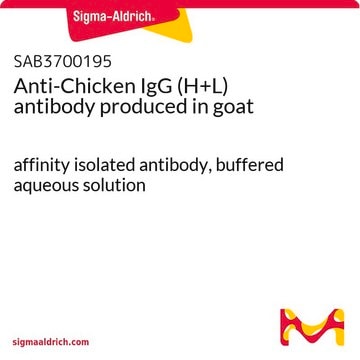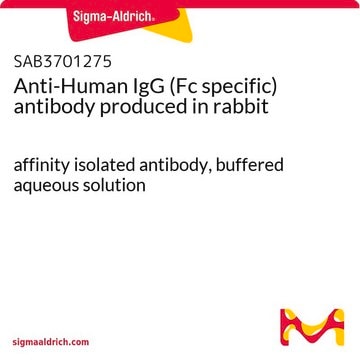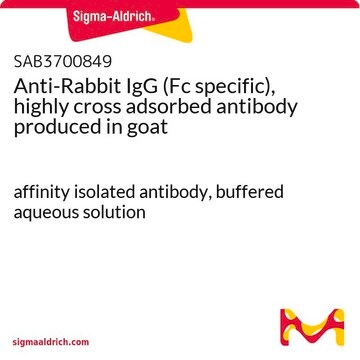SAB3700848
Anti-Rabbit IgG (Fc specific) antibody produced in goat
affinity isolated antibody, buffered aqueous solution
Iniciar sesiónpara Ver la Fijación de precios por contrato y de la organización
About This Item
Código UNSPSC:
12352203
NACRES:
NA.46
Productos recomendados
origen biológico
goat
Nivel de calidad
conjugado
unconjugated
forma del anticuerpo
affinity isolated antibody
tipo de anticuerpo
secondary antibodies
clon
polyclonal
Formulario
buffered aqueous solution
reactividad de especies
rabbit
concentración
1.99 mg/mL
técnicas
ELISA: suitable
immunohistochemistry: suitable
western blot: suitable
Condiciones de envío
wet ice
temp. de almacenamiento
2-8°C
modificación del objetivo postraduccional
unmodified
Descripción general
Immunoglobulin G (IgG) is a member of the immunoglobulin family and is a widely expressed serum antibody. The monomeric 150kDa structure of IgG constitutes two identical heavy chains and two identical light chains with molecular weight of 50kDa and 25kDa, respectively. The primary structure of this antibody also contains disulfide bonds involved in linking the two heavy chains, linking the heavy and light chains and resides inside the chains. IgG is further subdivided into four classes namely, IgG1, IgG2, IgG3, and IgG4 with different heavy chains, named γ1, γ2, γ3, and γ4, respectively. Limited digestion using papain cleaves the antibody into three fragments, two of which are identical and contain the antigen-binding activity. The third fragment does not possess antigen-binding activity and is known as fragment crystallizable (Fc). It interacts with cells and effector molecules. The Fc fragment contains the CH2 and CH3 domains of the antibody molecule. Maternal IgG is the only antibody transported across the placenta to the fetus. It passively immunizes the infants.
Immunoglobulin G (IgG) is made up of a γ heavy chain in the constant (C) region. The monomeric 150kDa structure of IgG constitutes two identical heavy chains and two identical light chains with molecular weight of 50kDa and 25kDa, respectively. The primary structure of this antibody also contains disulfide bonds involved in linking the two heavy chains, linking the heavy and light chains and resides inside the chains. IgG is further subdivided into four classes namely, IgG1, IgG2, IgG3, and IgG4 with different heavy chains, named γ1, γ2, γ3, and γ4, respectively. Limited digestion using papain cleaves the antibody into three fragments, two of which are identical and contain the antigen-binding activity. The third fragment does not possess antigen-binding activity and is known as fragment crystallizable (Fc). It interacts with cells and effector molecules. The Fc fragment contains the CH2 and CH3 domains of the antibody molecule. Maternal IgG is the only antibody transported across the placenta to the fetus. It passively immunizes the infants.
Especificidad
This product was prepared from monospecific antiserum by immunoaffinity chromatography using Rabbit IgG coupled to agarose. Assay by immunoelectrophoresis resulted in a single precipitin arc against Anti-Goat Serum, Rabbit IgG, Rabbit IgG F(c) and Rabbit Serum. No reaction was observed against Rabbit IgG F(ab′)2.
Inmunógeno
Rabbit IgG F(c) fragment
Aplicación
Anti-Rabbit IgG (Fc specific) antibody produced in goat has been used in immunohistochemistry.
Anti-Rabbit IgG (Fc specific) antibody produced in goat has been used in immunohistochemistry.
Propiedades físicas
Antibody format: IgG
Forma física
Supplied in 0.02 M Potassium Phosphate, 0.15 M Sodium Chloride, pH 7.2
Cláusula de descargo de responsabilidad
Unless otherwise stated in our catalog or other company documentation accompanying the product(s), our products are intended for research use only and are not to be used for any other purpose, which includes but is not limited to, unauthorized commercial uses, in vitro diagnostic uses, ex vivo or in vivo therapeutic uses or any type of consumption or application to humans or animals.
¿No encuentra el producto adecuado?
Pruebe nuestro Herramienta de selección de productos.
Código de clase de almacenamiento
12 - Non Combustible Liquids
Clase de riesgo para el agua (WGK)
nwg
Punto de inflamabilidad (°F)
Not applicable
Punto de inflamabilidad (°C)
Not applicable
Elija entre una de las versiones más recientes:
¿Ya tiene este producto?
Encuentre la documentación para los productos que ha comprado recientemente en la Biblioteca de documentos.
Los clientes también vieron
Inhibition of Reactive Gliosis in the Retina of Rats with Streptozotocin-Induced Diabetes under the Action of Hydrated C60 Fullerene
Victor S
Neurophysiologia null
Inhibition of Reactive Gliosis in the Retina of Rats with Streptozotocin-Induced Diabetes under the Action of Hydrated C60 Fullerene
Victor S
Neurophysiologia null
Jin Li et al.
Molecular therapy : the journal of the American Society of Gene Therapy, 29(3), 1102-1119 (2020-12-07)
Muscle atrophy is associated with negative outcomes in a variety of diseases. Identification of a common therapeutic target would address a significant unmet clinical need. Here, we identify a long non-coding RNA (lncRNA) (muscle-atrophy-associated transcript, lncMAAT) as a common regulator
Bryan Gosselin et al.
Analytical chemistry, 94(20), 7383-7390 (2022-05-14)
Dipstick assays using silver nanoparticles (AgNPs) stabilized by a thin calix[4]arene-based coating were developed and used for the detection of Anti-SARS-CoV-2 IgG in clinical samples. The calixarene-based coating enabled the covalent bioconjugation of the SARS-CoV-2 Spike Protein via the classical
Jin Li et al.
EBioMedicine, 81, 104108-104108 (2022-06-26)
Pathological cardiac hypertrophy occurs in response to numerous stimuli and precedes heart failure (HF). Therapies that ameliorate pathological cardiac hypertrophy are highly needed. The expression level of miR-30d was analyzed in hypertrophy models and serum of patients with chronic heart
Nuestro equipo de científicos tiene experiencia en todas las áreas de investigación: Ciencias de la vida, Ciencia de los materiales, Síntesis química, Cromatografía, Analítica y muchas otras.
Póngase en contacto con el Servicio técnico








